CobaltChloride
Hazard to Others
  
Posts: 239
Registered: 3-3-2018
Location: Romania
Member Is Offline
|
|
An interesting preparation of potassium chromate
I found this paper that showed that Cr2O3 dissolves very slowly in aqueous NaOH to make Na2CrO4 in the presence of air (https://sci-hub.tw/10.1021/ie302096e). Considering I want some hexavalent Cr salt and I wouldn't want to do chemplayer's method because it
involves too much splattering, I made two tests:
I= I added 1g of hardware store Cr2O3 (doesn't dissolve at all in 35.8% H2SO4) and 4.7g of Na2S2O8 to a vial. In a beaker I dissolved 3.69g of KOH in
15ml of water. After being chilled, this solution was added to the vial. I shook it vigorously and then left it for the night. The reaction I'm going
for is: Cr2O3 + 10 KOH + 3 Na2S2O8 = 2 K2CrO4 + 3 Na2SO4 + 3 K2SO4 + 5 H2O
II=Here I did the same as before, just on a 10 times smaller scale and I also added three drops of 0.1M AgNO3 to act as a catalyst.
In the photo there's the two vials after 12 hours of sitting. In the left there's the I vial, in the right there's the II vial. The liquid in both of
them is pale yellow, which is a good sign. Now let's see how much time it takes for all of the Cr2O3 to dissolve.
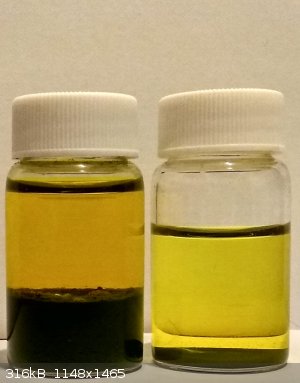
[Edited on 27-6-2018 by CobaltChloride]
[Edited on 27-6-2018 by CobaltChloride]
|
|
|
subskune
Hazard to Self
 
Posts: 71
Registered: 30-4-2017
Member Is Offline
Mood: No Mood
|
|
haha 80 days for one gram, way to slow, I guess bubbling won't make things better?
The hardware store stuff is somewhat resistant, I had it in boiling 98% sulfuric and nothing, not a single gram dissolved.
I just need soluble Cr3 salts.
What about adding some ammoniumsulfate and electrolysing the solution to form the persulfate in solution? You want to try?
|
|
|
CobaltChloride
Hazard to Others
  
Posts: 239
Registered: 3-3-2018
Location: Romania
Member Is Offline
|
|
Well here I added the sodium persulfate hoping that it would make things go faster by increasing the concentration of the oxidant. That's the same
reason why I added AgNO3 to the II vial: to make things go faster. I'd try the electrolysis of ammonium sulfate, but I don't yet have a good power
supply and sodium persulfate isn't an expensive chemical. Also, correct me if I'm wrong, but I know (NH4)2S2O8 is less resistant to hydrolysis than
the sodium counterpart, so for an experiment that takes so long, sodium persulfate is preferable.
[Edited on 27-6-2018 by CobaltChloride]
|
|
|
woelen
Super Administrator
        
Posts: 8012
Registered: 20-8-2005
Location: Netherlands
Member Is Offline
Mood: interested
|
|
Ammonium persulfate is quite bad actually. Several years ago I purchased 500 grams of Na2S2O8, 500 grams of K2S2O8 and 500 grams of (NH4)2S2O8. All
from the same eBay seller (Mineral Water Ltd. in the UK). The K2S2O8 and Na2S2O8 are still as good as when I purchased them, the (NH4)2S2O8 I had to
discard within one year after purchase. It became a nasty wet mess, and the plastic container had become very brittle. I dumped all of it, it had
become totally useless and lost all its oxidizing power. At the moment I just do with the sodium and potassium salt. I like the sodium salt most, the
potassium salt is only very sparingly soluble, which limits it usefulness.
|
|
|
subskune
Hazard to Self
 
Posts: 71
Registered: 30-4-2017
Member Is Offline
Mood: No Mood
|
|
| Quote: |
sodium persulfate isn't an expensive chemical
|
you're right. The reason I don't like it that much is that you need a lot off mass for an oxidation, the active part is only a small weight
percentage, for larger synth this will be massive amounts. Btw its the same issue with most persulfates.
|
|
|
DraconicAcid
International Hazard
    
Posts: 4332
Registered: 1-2-2013
Location: The tiniest college campus ever....
Member Is Offline
Mood: Semi-victorious.
|
|
The rate determining step in this reaction is the dissolution of Cr2O3 in base to give [Cr(OH)4]-. Once that's formed, the oxidation should be rapid.
Please remember: "Filtrate" is not a verb.
Write up your lab reports the way your instructor wants them, not the way your ex-instructor wants them.
|
|
|
CobaltChloride
Hazard to Others
  
Posts: 239
Registered: 3-3-2018
Location: Romania
Member Is Offline
|
|
Yeah, that's what I was thinking, but it seems that it's also the oxidzing power of the solution that makes it go faster because the one with silver
nitrate catalyst seems to go faster. I'll test this by also putting some Cr2O3 in plain aqueous KOH and see if the solution turns green at all. Also,
in that paper, all dissolved Cr2O3 is present as chromate; there's no Cr (III) so it may be that only oxidative environments are able to break the
crystalline structure of calcined Cr2O3 at a reasonable rate.
|
|
|
chemplayer...
Legendary
  
Posts: 191
Registered: 25-4-2016
Location: Away from the secret island
Member Is Offline
Mood: No Mood
|
|
How about just fusing an alkali nitrate, green chromium oxide, and potassium hydroxide together in a closed metal canister? I don't recall the mixture
'spattering' much, and if you crush the resulting cake up finely before extracting with boiling hot water, you can make it quite efficient and reduce
the evaporation step. Very simple and relatively OTC ingredients, quick, and reasonable yields of pure crystals.
|
|
|
CobaltChloride
Hazard to Others
  
Posts: 239
Registered: 3-3-2018
Location: Romania
Member Is Offline
|
|
I watched your video on that and it splatters quite a lot on the work area at some point and you need to cover the crucible. I don't really like the
fact that Cr (VI) gets into the air. Maybe I'll try to do it if this method isn't working, but it seems to do so far.
|
|
|
woelen
Super Administrator
        
Posts: 8012
Registered: 20-8-2005
Location: Netherlands
Member Is Offline
Mood: interested
|
|
Dissolving Cr2O3 in a solution of KBrO3 (or NaBrO3) and NaOH also works quite well. The Cr2O3 dissolves more easily in that.
|
|
|
subskune
Hazard to Self
 
Posts: 71
Registered: 30-4-2017
Member Is Offline
Mood: No Mood
|
|
does this work with kclo3 too, or naclo3
|
|
|
CobaltChloride
Hazard to Others
  
Posts: 239
Registered: 3-3-2018
Location: Romania
Member Is Offline
|
|
Update
The Cr2O3 didn't dissolve at all in plain KOH (the solution is still colorless).
Meanwhile, the reaction in vials I and II progressed quite nicely. My camera doesn't really reproduce the chromate color well, so excuse the quality
of the photo.
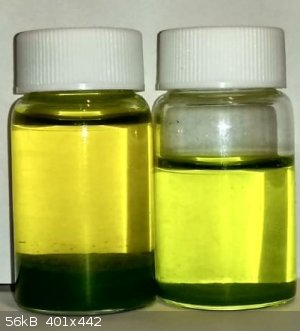
|
|
|
Doped-Al2O3-fusion
Hazard to Self
 
Posts: 99
Registered: 11-4-2018
Member Is Offline
Mood: Maniacal
|
|
I've created chromic chloride from Cr2O3 by using standard 31.45% HCL and 35% H2O2. I don't recall the stoichiometry I used, but to be honest, I
probably didn't pay close attention since it was early in my amateur chemist hobby. It took me a long time to crystallize the chromic chloride
solution, but was quickened once I decided to use a desiccator made from a medium sized disposable paint bucket using calcium chloride. I've also
dissolved elemental chromium using the same method, which starts out slow, but if you add a tiny bit of chromic chloride to the solution, it pushes
the reaction forward. I left it overnight not expecting to see much change, but I was surprised to find a dark green solution with just a slight
trace of undissolved elemental chromium.
Once I have the solution of chromic chloride I can add enough KOH to turn the solution basic, then proceed to oxidize the trivalent chromium into
hexavalent form, forming potassium chromate, then acidified the solution to form the potassium dichromate. I made a lot of mistakes in the process,
but eventually was successful which is all that mattered to me at the time. My efficiency on the processes was probably a 2 on a scale of 1 to 10.
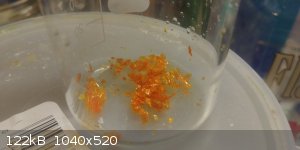
[Edited on 6-7-2018 by Doped-Al2O3-fusion]
[Edited on 6-7-2018 by Doped-Al2O3-fusion]
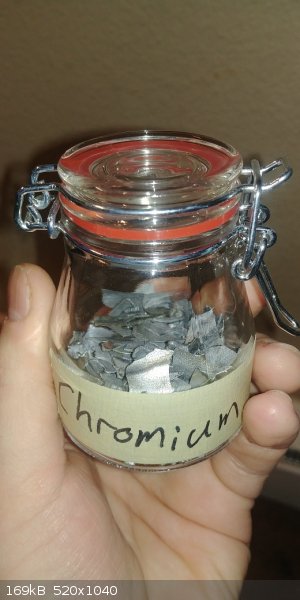 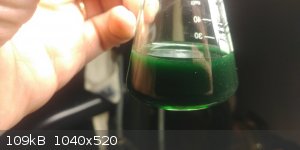
|
|
|
Doped-Al2O3-fusion
Hazard to Self
 
Posts: 99
Registered: 11-4-2018
Member Is Offline
Mood: Maniacal
|
|
Quote: Originally posted by CobaltChloride  | The Cr2O3 didn't dissolve at all in plain KOH (the solution is still colorless).
Meanwhile, the reaction in vials I and II progressed quite nicely. My camera doesn't really reproduce the chromate color well, so excuse the quality
of the photo. |
I used a borosilicate test tube to boil/roast, Cr2O3 with KOH before to obtain CrK2O4. KOH won't eat away at the glass nearly as quickly as NaOH, so
depending on the amount, you may want to find a stainless steal container or possibly a nickel crucible. I don't know if the KOH will react with the
nickel at the moment as I've never tried or researched that.
|
|
|
CobaltChloride
Hazard to Others
  
Posts: 239
Registered: 3-3-2018
Location: Romania
Member Is Offline
|
|
In the meantime, all of the Cr2O3 in my reaction has dissolved and now I only need to acidify it and cool it in an ice bath so that K2Cr2O7
precipitates. But I have one question: what is the source of the Cr2O3 you used to make CrCl3? If it's hardware store/pottery store Cr2O3 then I'd
like to try your HCl+H2O2 method and maybe H2SO4+H2O2 as that wouldn't make any chlorine
[Edited on 6-7-2018 by CobaltChloride]
|
|
|
Doped-Al2O3-fusion
Hazard to Self
 
Posts: 99
Registered: 11-4-2018
Member Is Offline
Mood: Maniacal
|
|
Quote: Originally posted by CobaltChloride  | In the meantime, all of the Cr2O3 in my reaction has dissolved and now I only need to acidify it and cool it in an ice bath so that K2Cr2O7
precipitates. But I have one question: what is the source of the Cr2O3 you used to make CrCl3? If it's hardware store/pottery store Cr2O3 then I'd
like to try your HCl+H2O2 method and maybe H2SO4+H2O2 as that wouldn't make any chlorine
[Edited on 6-7-2018 by CobaltChloride] |
I got mine from an eBay pottery supplier. The stuff seems fairly pure as they claim too surprisingly. I highly suggest getting pure chromium from
Chinese suppliers too with a good reputation. I seemed to have a much more concentrated solution using the elemental form rather than the oxide.
Another suggestion I have is to warm the solution too. I think I heated up to 35 deg Celsius, but not much higher. My home lab was around 10 degrees
during that timeframe so I needed go kick start reactions with a little warming anyways.
I will see if I can find the seller info from eBay when I am on my computer later.
|
|
|